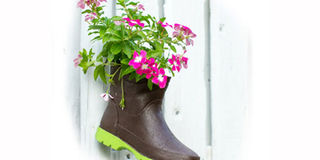Make your own plant containers

Rain boot planters
What you need to know:
Good planters should not be hard to find. You can make your own.
The beautification of our homesneed not cost an arm and a leg. Here are some ideas on how to make them in the comfort of your home:
Wooden crates
After years of turning crates that carried screws and hinges for her mother’s hardware shop into firewood, Veronica Muganzi, a homeowner found a new purpose for them. “Though small, the wood was sturdy and seemed to withstand elements of weather well. As such, I turned those I could salvage into planters for my herbs and spices that have shallow roots such as rosemary, mint. That means drilling some holes underneath for drainage, moss linen to preserve the wood and compost soil for proper draining,” says Muganzi. For the fresh supply of vegetables, herbs and spices, Muganzi is on her way to fulfilling her dream.
Ian Galabuzi, a plant lover adds that one can also use these wooden boxes, more so if you can get bigger ones to conceal unappealing planters. “These could be worn out plastic planters yet you are not willing to go through the pains of transplanting. The boxes could also work if you desire to give your yard a facelift with the character these boxes bring.”
Yogurt tins
Irene Kitui, a gardener, says the one litre tins are ideal because they are bigger. “If you do not mind having the brand names, then the next step would be carefully putting holes beneath the tin. However, for a personality touch, spraying the tin to the colour of your choice will be great.” She adds that they are a great way to introduce container planting to children since the containers are cheap to come by.
That said, small plants, with shallow roots are the best fit here. These include mint and coriander as long as you tame them so that they do not overrun the tins.
Upside down planters
Tired of the tins collecting in your kitchen because you are not sure about what to use them for yet you do not want to throw them away? You might just turn them into upside down planters to add drama to your space. Mwali says rather than have chandeliers, one could have plants. “One can that will come in handy is a peanut tin with a cover. Like you would any container intended for plants, drill some holes at the bottom, fill it with soil and put in the plant. Then to keep the soil intact, get a coffee filter and cut out the diameter of the tin’s bottom. Then cut a circle which is the diameter of the plant’s stem, before doing the same for the tin cover.
With the filter and cover covering the tin, flip the planter for your unique planter.
Brick planters
Bricks are used for building, but this time, we want to turn them into planters. The idea is, owing to their height, these will do great for succulents whose root system is not complex. Namagembe says the hard part is drilling a hole into the brick without breaking it. “All it takes is patience so that the shock is minimised,” she adds.
Tree stumps
It is nature inhabiting nature when you turn those cut tree trunks into planters. Faith Kakai, a gardener, reminisces about using coconut tree logs for planters “After cutting the overgrown plants, an idea came to mind to use these trunks as decorators would, only this time, the project required trunks of 10 inches or more and they would sit around for a while,” she says. Kakai adds that these planters can be used to beautify a fence by placing them along it. She adds that if one can get those of hard trees which are brown in colour, the longevity is guaranteed and the colour adds character to the place.
Rain boot planters
Their boots had worked well that the bottoms spoke of age but throwing them away was something none would think of for they loved them. That is why Isaiah Kintu, a homeowner chose to turn these rain/work boots into planters so they remain around.
“These can hang along the fence and add a lot of beauty to the yard with their splash of colour,” he explains.
Teacup planters
The thought of using a cup as a planter might seem bizarre given the size. However, for those small plants that will sit well on window sill, these cup planters are ideal. “Couple the outer cup decorations with a few small smooth stones, and your succulents will further brighten the windows,” Muganzi shares.





